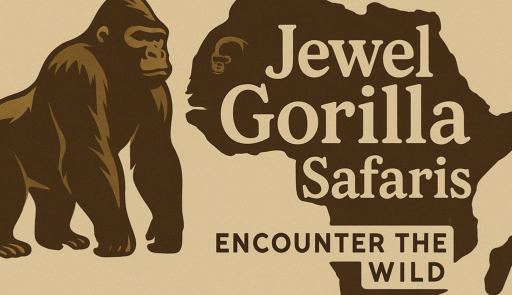Is Gorilla Trekking Safe? Everything You Need to Know For First Timers
Gorilla trekking is one of the most thrilling wildlife experiences on Earth — but before booking your permit, it’s natural to ask, is gorilla trekking safe? This is a common and important question among travelers planning a safari in Uganda, Rwanda, or DR Congo. Whether you’re preparing for a guided hike through Bwindi Impenetrable Forest, Volcanoes National Park, or Virunga National Park, safety is always a top concern.
The good news is this: gorilla trekking is safe when done with a licensed tour operator, under the protection of experienced park rangers, and within the established rules of the gorilla tourism industry. Every trek into the jungle is carefully managed to minimize risk — both to visitors and to the endangered mountain gorillas themselves.
In this guide, we’ll answer the big question — is gorilla trekking safe in Uganda, Rwanda, and Congo? We’ll explore how governments and conservation bodies keep the activity secure, what safety measures are in place, and what you can do as a visitor to stay safe throughout your adventure.
By the end of this blog, you’ll understand why thousands of tourists ask “is gorilla trekking safe?” every year — and why the answer, backed by data, policy, and professional support — is a confident yes.
Is Gorilla Trekking Safe in 2025, 2026, 2027, and 2028?
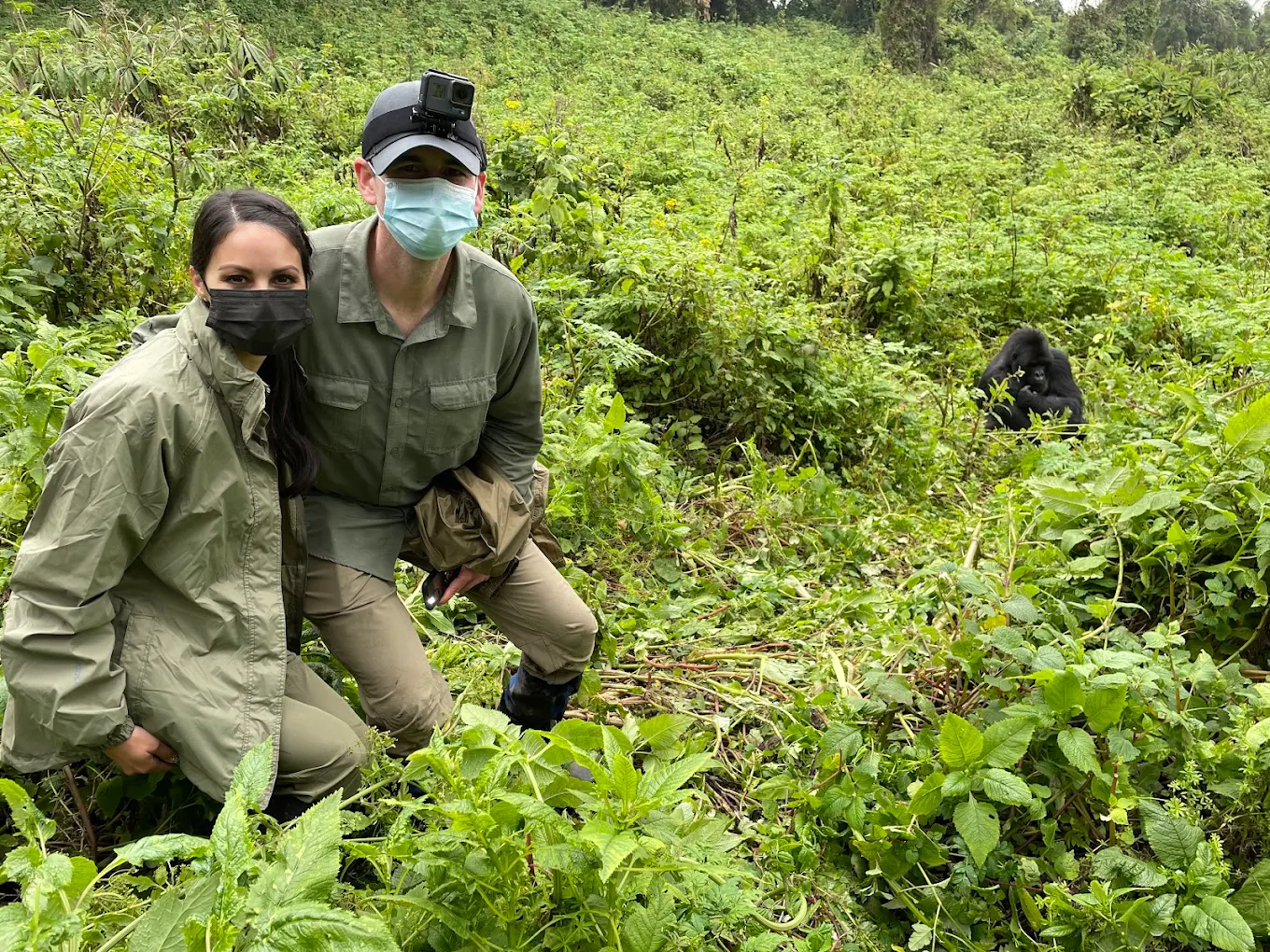
As we move through 2025 and plan for upcoming safari seasons in 2026, 2027, and 2028, more travelers are asking a vital question: is gorilla trekking safe now and in the future? The short answer is yes — and in fact, gorilla trekking is safer today than ever before, thanks to increased conservation funding, ranger protection, and organized tourism practices across East and Central Africa.
In countries like Uganda, Rwanda, and DR Congo, gorilla trekking is a highly regulated activity. Only a limited number of permits are issued each day, treks are guided by professional trackers and armed park rangers, and every visitor receives a mandatory safety briefing. These practices are designed to ensure your safety in the forest, as well as the well-being of the mountain gorillas you’ll encounter.
Why 2025–2028 Will Be the Safest Years Yet
Tourism boards and conservation bodies in all three gorilla trekking countries have made substantial investments leading into 2025 and beyond. Uganda’s Uganda Wildlife Authority (UWA), Rwanda’s Rwanda Development Board (RDB), and Congo’s Virunga Foundation have strengthened safety systems with:
- More ranger patrols and anti-poaching units
- Real-time surveillance in high-risk areas
- Community policing and local guide training
- Enhanced COVID-19 and zoonotic disease protocols
These efforts make the experience increasingly secure for both tourists and wildlife. If you’ve been wondering is gorilla trekking safe in 2025, the answer is yes — and it’s only getting better in 2026, 2027, and 2028.
Gorilla Trekking Is Not a Solo Activity
Another reason gorilla trekking is safe is because you’re never alone. Every trek is conducted in a small group of 6 to 8 people, led by expert trackers and protected by armed rangers who monitor the trails. The paths taken are cleared of potential risks, and every gorilla group you visit has been habituated, meaning they’re accustomed to human presence and show no aggression when approached respectfully.
Is Gorilla Trekking Safe in Uganda?
If you’re wondering is gorilla trekking safe in Uganda, the answer is a confident yes. Uganda is one of the most popular and well-organized gorilla trekking destinations in Africa, offering two major trekking areas: Bwindi Impenetrable National Park and Mgahinga Gorilla National Park. Both parks are managed by the Uganda Wildlife Authority (UWA) — a government body known for its professional conservation, safety, and tourism standards.
Security Measures in Uganda’s Gorilla Parks
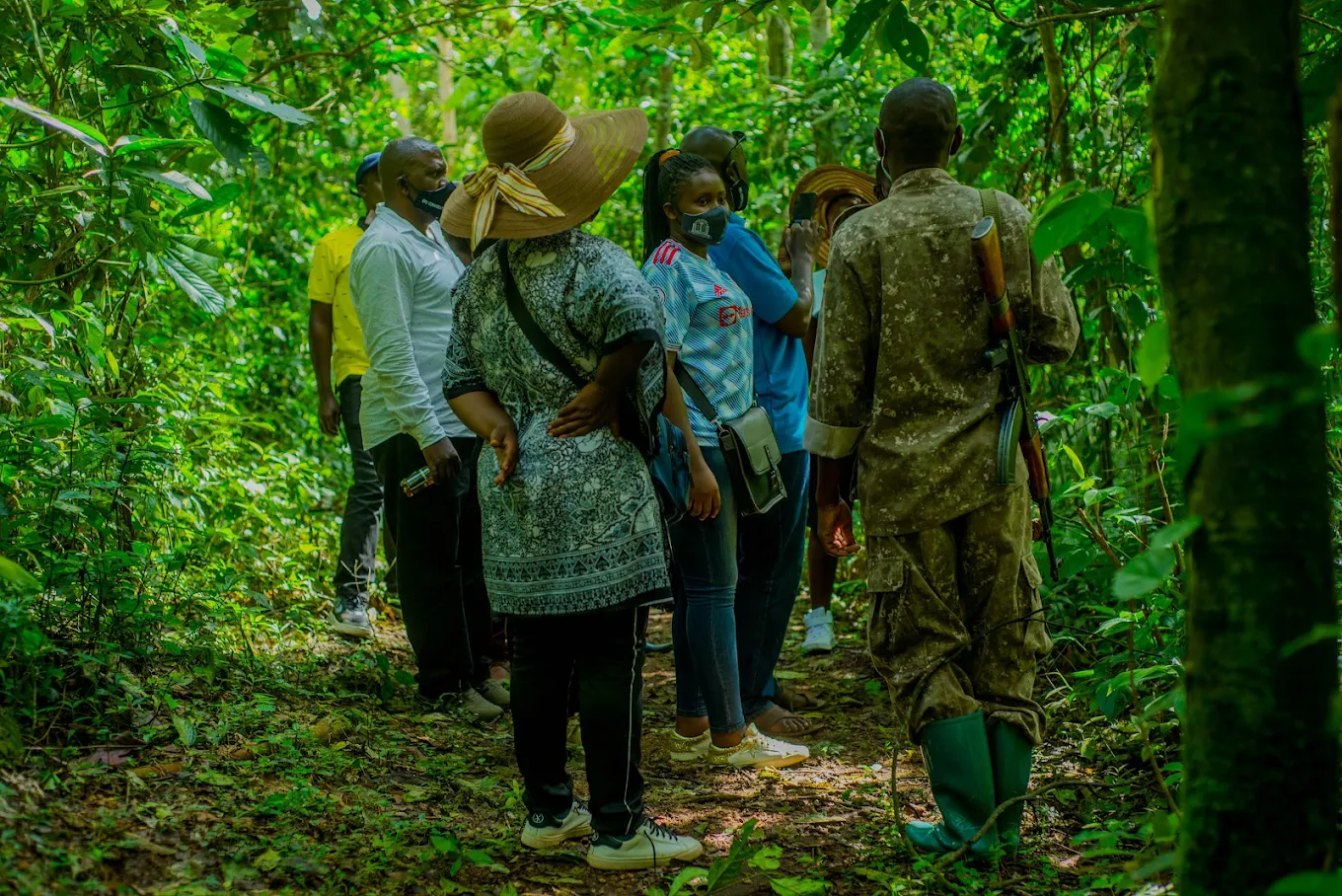
Uganda has built a reliable and transparent safety system around gorilla trekking. Every trek is led by a professional UWA guide and accompanied by armed rangers, whose job is to protect both tourists and wildlife. These rangers are trained in forest navigation, animal behavior, first aid, and emergency response — ensuring your safety even in the unlikely event of unforeseen circumstances.
In Bwindi and Mgahinga, there are no wild or unhabituated gorilla groups accessible to visitors. All families that tourists visit have been habituated over years of non-threatening contact, making gorilla encounters peaceful, awe-inspiring, and safe.
Community Support & Anti-Poaching Patrols
Safety in Uganda’s gorilla trekking sectors is also enhanced by strong local community involvement. In areas like Buhoma, Rushaga, Nkuringo, and Ruhija, local guides, porters, and rangers work together to ensure safety and accountability. UWA also runs daily patrols and collaborates with community scouts to deter poaching and illegal forest access.
This network of protection has helped Uganda maintain a stellar track record. If you’re asking is gorilla trekking safe in Uganda in 2025, 2026, or beyond, you can feel confident in both the security infrastructure and the conservation ethics at play.
Emergency Access and Medical Support
Though gorilla trekking in Uganda often takes place in remote, forested regions, emergency systems are in place. Rangers carry radios to communicate with base stations. In more popular trailheads like Buhoma and Rushaga, medical support is never far — and evacuation plans can be activated if needed.
Plus, the trekking pace is tailored to the group, meaning you won’t be pushed beyond your comfort level. Trekkers of varying ages and fitness levels — from young adventurers to retirees — regularly and safely complete Uganda’s treks.
Whether you’re planning a one-day trek from Kisoro, a multi-day safari from Kampala or Entebbe, or crossing in from Kigali, Uganda remains one of the safest and most rewarding gorilla trekking destinations in Africa.
Is Gorilla Trekking Safe in Rwanda?
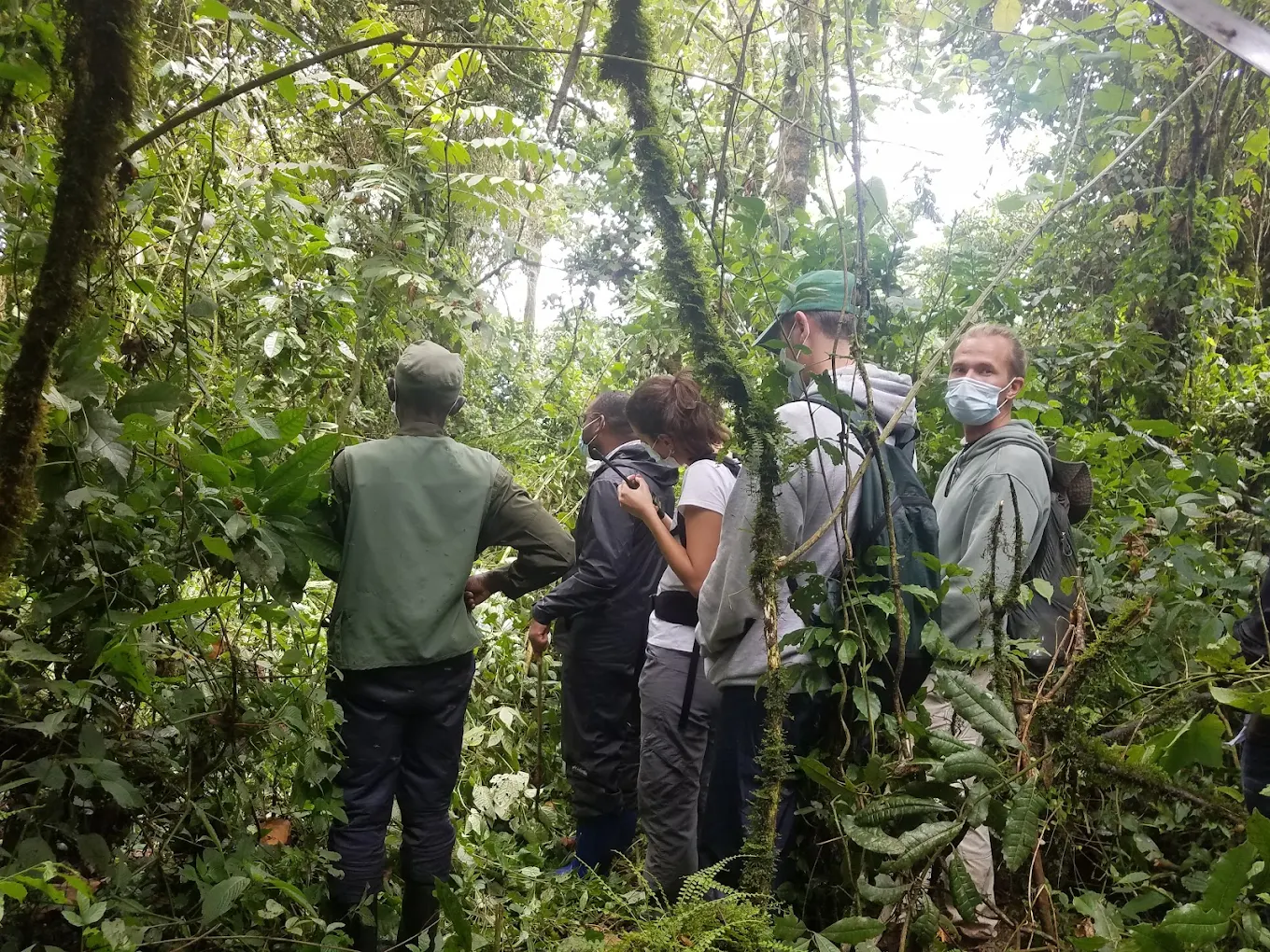
Rwanda has built a global reputation as one of the safest and most professionally managed destinations for gorilla trekking. If you’re asking, is gorilla trekking safe in Rwanda, the answer is a resounding yes. The country’s compact geography, top-tier infrastructure, and seamless tourism policies make Volcanoes National Park a favorite for travelers seeking both comfort and security in 2025, 2026, 2027, and beyond.
Government Oversight & Ranger Protection
Rwanda’s gorilla tourism is managed by the Rwanda Development Board (RDB) — a centralized agency that oversees all conservation and tourism activities. Gorilla trekking in Volcanoes National Park is strictly regulated. Permits are limited, trek group sizes are small, and every trek is led by experienced trackers and accompanied by armed rangers who ensure your safety throughout the hike.
Visitors receive a mandatory pre-trek briefing covering gorilla behavior, trekking protocols, and how to stay safe in the forest. The park staff speak multiple languages and are highly trained in guest management and wildlife protection.
Why Rwanda Is Considered the Safest for Gorilla Trekking
Many travelers consider Rwanda to be the safest destination for first-time gorilla trekking — and here’s why:
- Short driving distance (2.5 hours) from Kigali to the park
- High success rate of gorilla sightings (close to 100%)
- Strong national security and low crime rate
- High-quality lodges and road infrastructure
- Exceptional ranger-to-tourist ratio in the park
These factors contribute to an organized, low-risk experience. If you’re traveling solo or on a short timeline, Rwanda provides peace of mind and efficiency without compromising on wildlife quality.
Health & Safety Protocols in Rwanda
Even during health-sensitive times such as the COVID-19 era, Rwanda has maintained some of the most stringent health safety protocols in Africa. Today, the country still upholds mask mandates for close-range wildlife activities and maintains sanitation stations at park entry points.
When considering is gorilla trekking safe in Rwanda in 2025 or 2026, keep in mind that its policies continue to evolve with global best practices. Rwanda leads with an eco-conscious, low-risk approach that puts both the traveler and the gorillas first.
If you’re seeking a streamlined, luxury-oriented gorilla trekking experience with maximum safety and comfort, Rwanda is likely your best choice.
Is Gorilla Trekking Safe in DR Congo?
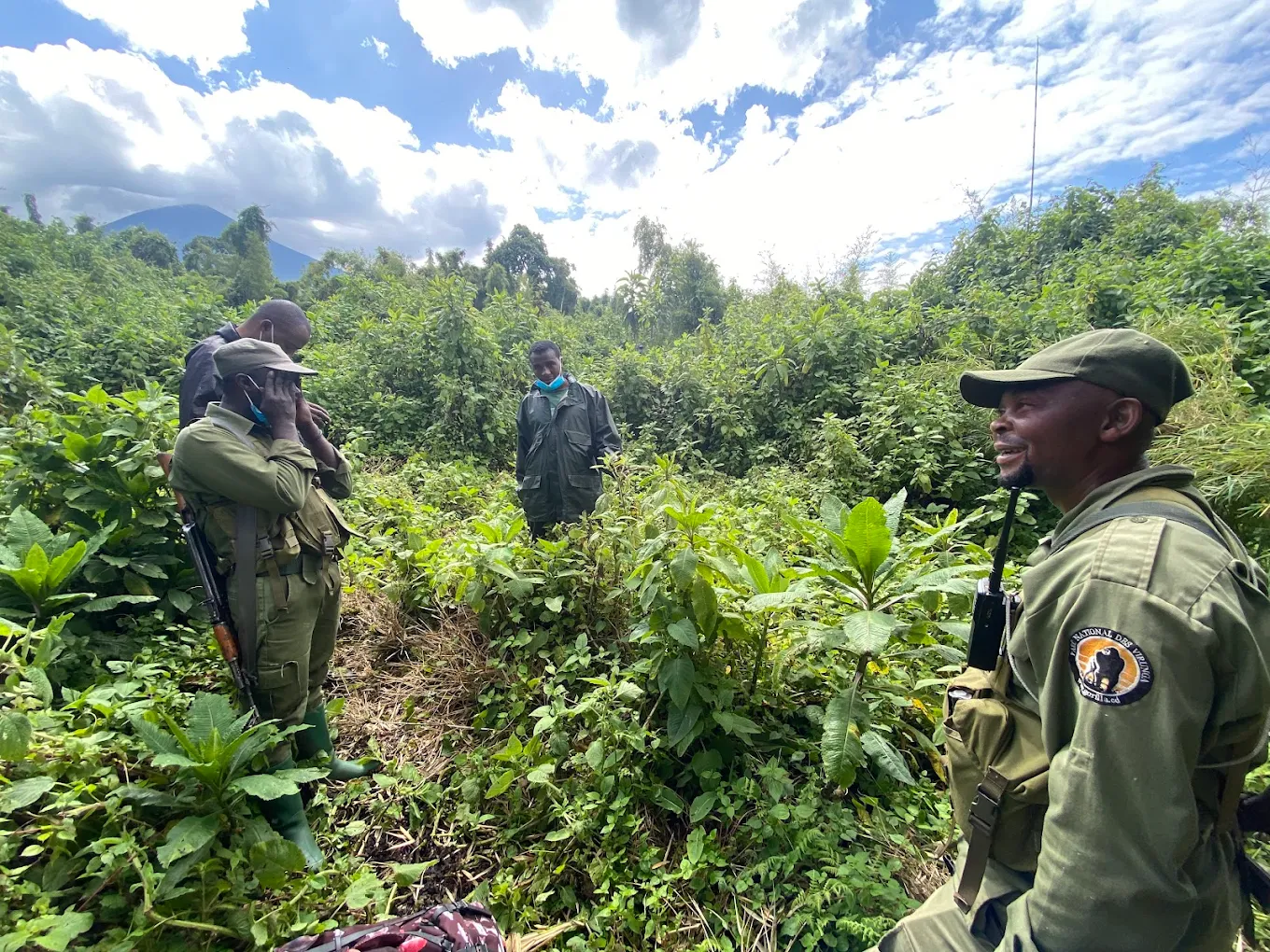
When people ask, is gorilla trekking safe in Congo, the answer requires nuance. DR Congo, particularly Virunga National Park, offers some of the most raw and authentic gorilla trekking experiences on the continent — but it has also faced challenges related to regional instability.
That said, with the right tour operator and up-to-date information, gorilla trekking in Congo can be safe, affordable, and deeply rewarding. In 2025 and beyond, improvements in tourism security are making Virunga more accessible to adventurous travelers.
Security Measures and Ranger Protection in Congo
Virunga National Park is protected by its own elite ranger force, operated by the Virunga Foundation, in collaboration with the Congolese Institute for the Conservation of Nature (ICCN). These rangers are highly trained in combat, surveillance, and wildlife protection, and they accompany every tourist group entering the park.
If you’re wondering is gorilla trekking safe in DR Congo in 2025 or 2026, it’s important to note that treks are only permitted during periods of verified stability. Park management has strict protocols and often suspends trekking when conditions are not secure.
All visitors must:
- Book through licensed operators with Virunga access
- Attend safety briefings
- Be accompanied by armed escorts and park rangers
- Stay in approved accommodations (such as Mikeno Lodge or Bukima Tented Camp)
Why Trekking in Congo Appeals to Some Travelers
Despite its challenges, Congo offers unique advantages:
- Cheapest gorilla trekking permits in Africa at only $400
- Stunning natural diversity and fewer tourists
- The chance to see lowland and mountain gorillas
- Contribution to a park that supports ranger families and widows
If you’re an experienced traveler seeking an off-the-beaten-path adventure, Congo’s gorilla trekking — while requiring caution — is an incredible option. But always ask: is gorilla trekking safe in Congo right now? This will vary depending on regional activity, border status, and park advisories.
Key Advice for Congo Gorilla Treks in 2025–2028
- Always check the latest travel advisory for Eastern DRC
- Use trusted safari companies with Virunga partnerships
- Combine Congo with Rwanda or Uganda for added flexibility
- Be aware of visa and security checkpoint procedures when crossing through Goma
In short, is gorilla trekking safe in DR Congo? With proper planning, local support, and current intel — yes. But it’s not for everyone. For many, Uganda or Rwanda may offer greater peace of mind, especially for first-time trekkers or families.
Gorilla Trekking Safety Comparison: Uganda vs Rwanda vs DR Congo (2025–2028)
| Country | Park | Permit Cost (USD) | Ranger Protection | Safety Rating (2025–2028) |
|---|---|---|---|---|
| Uganda | Bwindi & Mgahinga | $800 | Armed UWA Rangers + Daily Patrols | ★★★★★ (Very Safe) |
| Rwanda | Volcanoes National Park | $1,500 | RDB Guides + High Ranger Ratio | ★★★★★ (Very Safe) |
| DR Congo | Virunga National Park | $400 | Virunga Rangers + Armed Escorts | ★★★☆☆ (Safe with Precautions) |
What Makes Gorilla Trekking Safe?
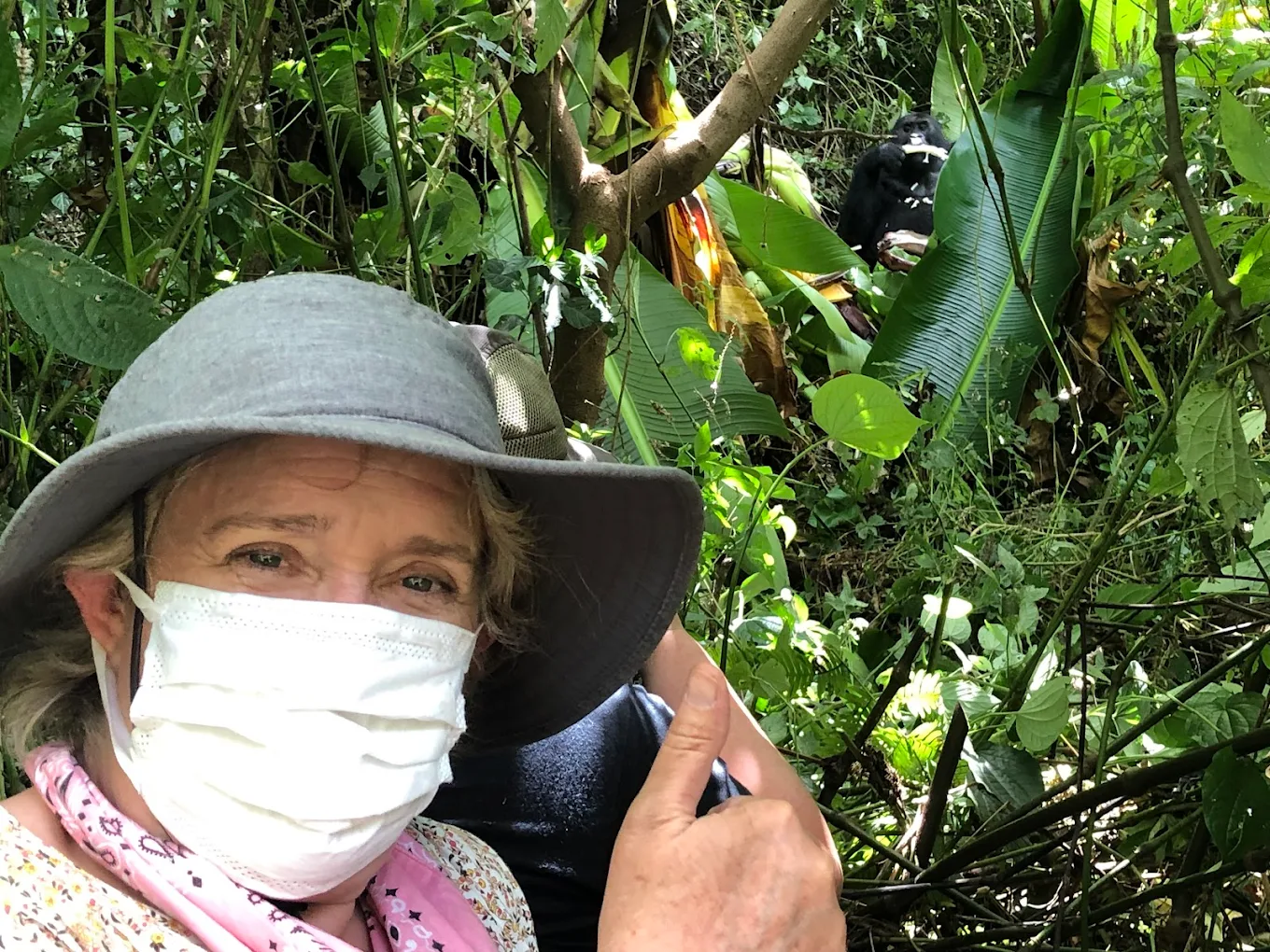
Gorilla trekking may take place in remote forests, but it’s far from a reckless activity. If you’re still wondering what makes gorilla trekking safe, it’s the combination of professional regulation, ranger support, small group management, and years of conservation experience that ensures both traveler and gorilla safety.
1. Gorilla Habituation: A Peaceful Encounter
One of the most important reasons gorilla trekking is safe is because of the habituation process. Before any gorilla group is opened to tourism, they undergo a slow and controlled introduction to humans by researchers and trackers. This process takes up to two years and ensures the gorillas are relaxed and non-aggressive when visitors are nearby.
These are not wild encounters with unhabituated animals — you are visiting families that are accustomed to human presence.
2. Small Group Sizes
To protect both visitors and gorillas, group sizes are limited. Each trek allows a maximum of 8 people to visit a single gorilla group per day. This reduces stress on the animals and ensures better control by the ranger team.
Smaller groups also mean that guides and trackers can focus more on each person’s safety and comfort — another layer of protection that makes people feel confident when they ask, is gorilla trekking safe in 2025 or 2026?
3. Professional Briefings Before Each Trek
Before every trek begins, all participants receive a mandatory safety briefing from the park rangers. This session covers:
- How to behave near gorillas
- Safe distances (7 meters or more)
- What to do if a gorilla approaches
- How to avoid health risks (like coughing or sneezing near the gorillas)
- What to wear and carry
These briefings help eliminate surprises and ensure everyone is prepared, both mentally and physically.
4. Armed Ranger Escort
Every gorilla trekking group is escorted by armed rangers, not because of wildlife aggression, but to ensure human safety. These rangers are trained in:
- Navigation through the forest
- Wildlife defense (if needed)
- Emergency evacuation
- First aid and guest safety
If you’re asking is gorilla trekking safe in places like Bwindi or Volcanoes National Park, this armed protection is one of the main reasons it is.
5. Strict Trekking Rules for Visitors
The rules of gorilla trekking are designed to reduce risk and promote safety:
- No flash photography
- No touching or getting too close
- No trekking if you’re sick
- Limited time (1 hour) with the gorillas
- Always follow ranger instructions
These protocols make gorilla trekking a safe, structured, and responsible activity across Uganda, Rwanda, and DR Congo.
Safety Tips for Gorilla Trekking in Uganda, Rwanda, and DR Congo
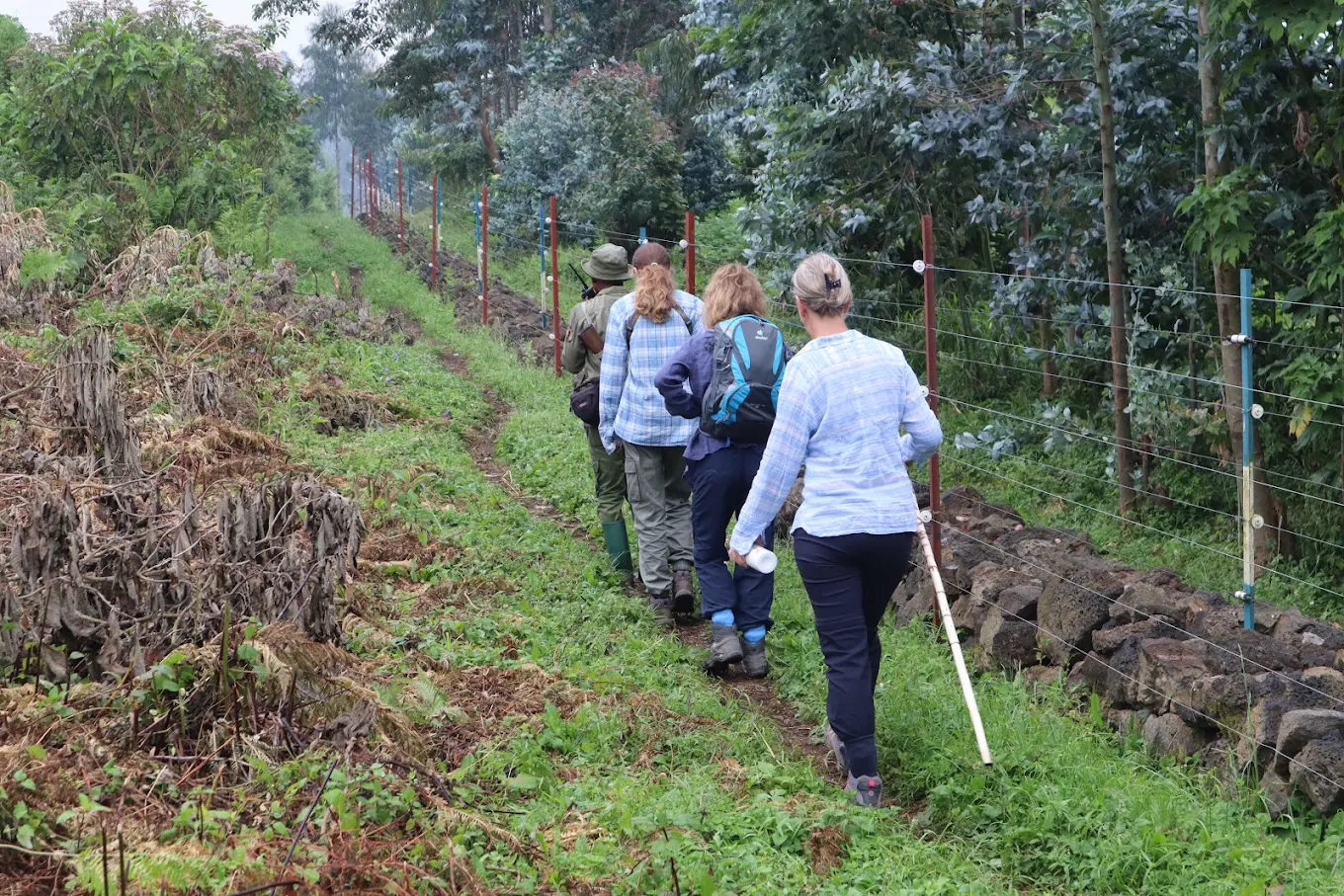
While the answer to is gorilla trekking safe is yes, your personal preparation plays a big role in ensuring a smooth, enjoyable experience. Here are expert-approved safety tips for gorilla trekking in Uganda, Rwanda, and DR Congo, updated for 2025 to 2028.
These safety tips will help you avoid common mistakes and stay protected throughout your journey.
1. Dress Appropriately for the Jungle
The forest can be wet, muddy, and thick with vegetation. Wearing the right gear makes a big difference:
- Waterproof hiking boots with good ankle support
- Long-sleeved shirts and long trousers to avoid insect bites and scratches
- Rain jacket or poncho for unpredictable showers
- Garden gloves to protect your hands on steep paths
These basics help reduce injuries and discomfort — a key factor in making gorilla trekking safe and manageable for all age groups.
2. Follow the 7-Meter Rule
Always maintain a distance of at least 7 meters (22 feet) from the gorillas. This protects the gorillas from human illnesses and minimizes the chance of startling them.
Even though the gorillas are habituated, they are still wild animals. Keeping your distance is one of the most effective gorilla trekking safety tips across all three countries.
3. Listen to Your Ranger at All Times
Your ranger is your lifeline in the forest. Whether you’re trekking in Bwindi, Volcanoes, or Virunga, always follow your ranger’s instructions — from how to position yourself near the gorillas to when to move or stay still.
Rangers are trained in gorilla behavior, first aid, and emergency response, and they’ll alert you to any situation before it becomes a risk.
4. Stay Quiet, Calm, and Respectful
Sudden movements, loud voices, or pointing at gorillas can be misinterpreted as threats. Stay calm, move slowly, and enjoy the moment in silence or with hushed tones.
One of the reasons people ask is gorilla trekking safe is due to fear of the gorillas themselves — but your calm demeanor greatly reduces any chance of conflict.
5. Protect Your Health — and Theirs
To keep both you and the gorillas safe, you should:
- Not trek if you have a cold or flu
- Carry hand sanitizer or wipes
- Wear a mask when close to the gorillas (recommended)
- Drink clean bottled or filtered water
- Bring insect repellent and sunscreen for forest edges
These tips are especially important in the age of zoonotic diseases — gorillas share about 98% of our DNA and are vulnerable to human infections.
6. Book with a Licensed Operator
Perhaps the most important tip of all: always book with a licensed tour company. A company like Jewel Gorilla Safaris or Nextgen Safaris ensures you receive;
- Verified park permits
- Knowledgeable guides
- Compliant transport and accommodation
- Real-time safety updates, especially for DR Congo treks
Booking with the right operator is what turns a good trek into a great, safe one.
What About Health and Disease Risk?
Another common concern behind the question “is gorilla trekking safe?” is the risk of disease transmission — both from humans to gorillas, and vice versa. Since mountain gorillas share about 98% of our DNA, they are highly susceptible to human illnesses, including colds, flu, and respiratory infections like COVID-19.
For this reason, gorilla trekking authorities in Uganda, Rwanda, and DR Congo have implemented strict health protocols to minimize disease risk — especially as global tourism increases post-pandemic in 2025, 2026, and beyond.
Gorilla Health Is Directly Linked to Human Behavior
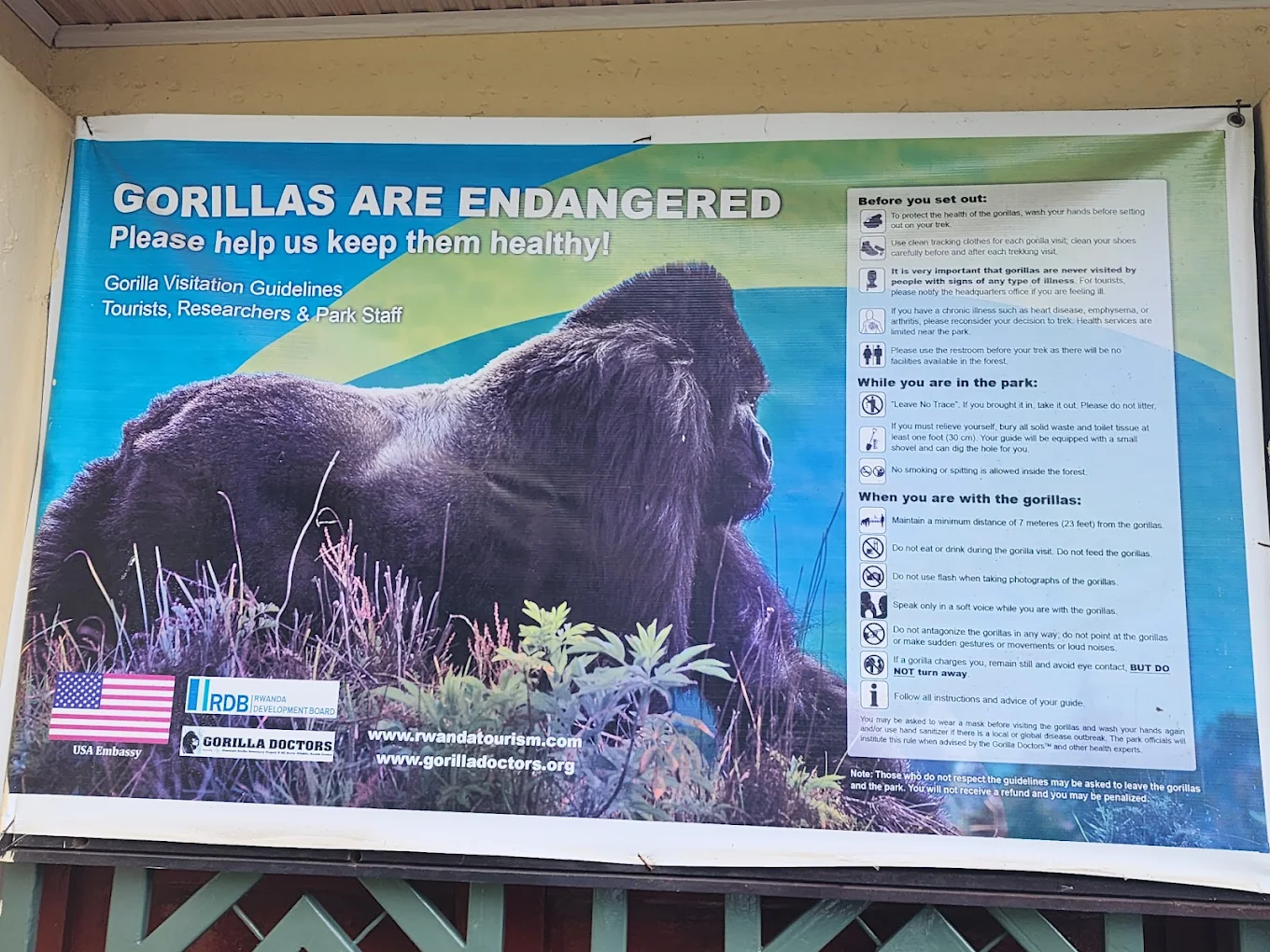
The safety of your trek isn’t just about your physical wellbeing — it also depends on how well human health is managed in protected areas. Here’s what each country is doing to ensure that gorilla trekking remains safe and responsible:
Uganda
- Visitors must undergo pre-trek screening and temperature checks
- Wearing a face mask near gorillas is strongly advised
- Rangers carry sanitizer, and tourists must declare flu-like symptoms
Rwanda
- Rwanda has some of the strictest health guidelines in Africa
- Face masks are mandatory when approaching gorilla families
- All trekking groups are kept small and sanitized gear is encouraged
DR Congo
- Visitors must follow Virunga’s health guidelines
- Only travelers who pass pre-trek assessments are allowed in
- Guides are trained to deny entry to anyone showing symptoms
What You Can Do to Minimize Health Risks
To keep your experience safe and ethical, follow these essential health precautions:
- Postpone trekking if you’re feeling sick
- Bring a clean face mask or two (disposable or reusable)
- Avoid close contact with locals or other groups before trekking
- Stay hydrated and travel with medical insurance
- Bring your own hand sanitizer, insect repellent, and wipes
If you’re still asking, is gorilla trekking safe during disease outbreaks, rest assured that tour operators and park authorities take this risk seriously — and have built systems that prioritize long-term health protection for both humans and gorillas.
Final Thoughts – Is Gorilla Trekking Worth the Risk?
So, is gorilla trekking safe in 2025, 2026, 2027, or even 2028? Based on every measure of tourism, conservation, and security — the answer is yes. Whether you choose Uganda’s Bwindi Impenetrable Forest, Rwanda’s Volcanoes National Park, or DR Congo’s Virunga National Park, you’ll find structured systems, expert guides, ranger protection, and well-established safety protocols in place.
Of course, no adventure comes without risk. But the risks involved in gorilla trekking are low and managed with precision — especially when compared to the reward: a deeply personal, once-in-a-lifetime encounter with one of the most majestic and endangered animals on Earth.
If you’re still asking, is gorilla trekking safe for solo travelers, seniors, or first-timers, the answer remains the same — with the right preparation, reputable tour operators, and respect for the rules, gorilla trekking is safe, inspiring, and unforgettable.
For the most secure and seamless gorilla trekking experience:
- Choose a licensed company like Jewel Gorilla Safaris or Nextgen Safaris
- Travel during the dry seasons for easier trekking conditions
- Book in advance to secure permits and reputable guides
Ready to plan your trek?
If you’ve read this far, you likely understand that gorilla trekking is safe — and more than that, it’s one of the most responsible and impactful wildlife experiences you can take part in.
FAQs; Is Gorilla Trekking Safe?
1. Is gorilla trekking safe for solo travelers?
Yes. Solo travelers are grouped with other trekkers and always guided by professional trackers and armed rangers. Whether in Uganda, Rwanda, or Congo, you’ll never enter the forest alone.
2. Is gorilla trekking safe for seniors or older adults?
Absolutely. Many trekkers in their 50s, 60s, and even 70s successfully complete gorilla treks every year. You can request a shorter or easier trail and hire a porter to assist.
3. Is gorilla trekking safe during the rainy season?
While trails can be slippery during the wet months (March–May and November), gorilla trekking is still safe. Rangers adjust pacing, and proper gear (boots, rain jackets) is strongly recommended.
4. Is gorilla trekking safe in DR Congo?
Congo offers safe trekking experiences in Virunga National Park, but it requires extra caution. Only trek when the park is officially open and use licensed operators who coordinate with park security.
5. What safety measures are in place during a gorilla trek?
Every trek is escorted by armed rangers. Briefings are held before departure. Rules include: no flash photography, stay 7 meters away, wear masks near gorillas, and always follow your guide.
6. Can I get sick from the gorillas or vice versa?
Yes, which is why health screening, mask-wearing, and distance rules are enforced. Gorilla trekking is safe as long as you follow the health guidelines and do not trek if you’re unwell.
7. Is gorilla trekking worth it despite the risks?
If you’re wondering is gorilla trekking safe and worth the cost, the answer is yes. It’s a low-risk, highly rewarding wildlife adventure that supports conservation and provides lifetime memories.
Ready to Trek Safely With the Experts?
Gorilla trekking is not only safe — it’s life-changing when done with the right team. At Jewel Gorilla Safaris, we provide fully guided, ranger-protected treks in Uganda, Rwanda, and DR Congo, tailored to your fitness level, schedule, and comfort.
Whether you’re planning your first trek in 2025 or returning in 2028, our expert team ensures safety, seamless logistics, and authentic encounters.
